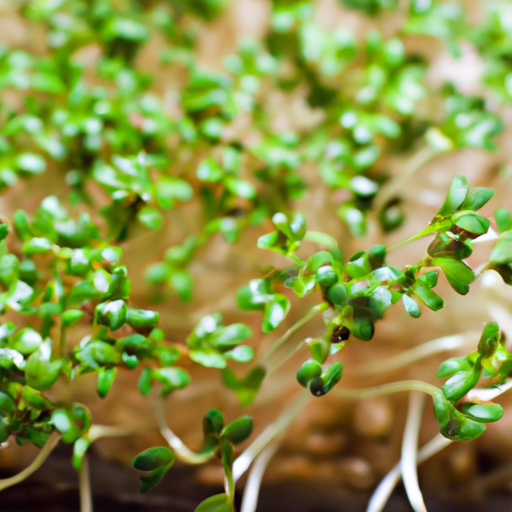Discover the Delightful Garden Cress Leaves: A Must-Have in Your Culinary Repertoire
Have you ever come across those tiny, delicate leaves with vibrant green hues known as garden cress? If not, you are in for a delightful surprise! Garden cress leaves, also known as Lepidium sativum, are a culinary gem that adds a burst of freshness to any dish. From their distinct taste and versatile uses to their remarkable nutritional profile, garden cress leaves are certainly an ingredient worth exploring. So, join us as we dive into the world of garden cress and unlock its hidden potential in the culinary realm.
Taste and Culinary Uses
Garden cress leaves possess a unique flavor profile that blends crispness with a slightly peppery or tangy hint. This makes them a popular choice for enhancing the taste of various dishes. These delicate leaves serve as an ideal garnish, offering a pop of vibrant green color alongside their refreshing taste.
One of the most common uses of garden cress is in salads, where its vibrant green leaves elevate both the visual appeal and the flavor. Imagine a bed of crisp lettuce adorned with a scattering of garden cress leaves, contributing their zesty, peppery bite. It’s an instant flavor booster!
These versatile leaves are not limited to just salads, though. Garden cress can be incorporated into sandwiches and wraps, giving them a delightful crunch and a burst of fresh flavor. Additionally, they can be added to soups, stews, and stir-fries, imparting their unique taste and adding a touch of visual appeal.
Nutritional Powerhouse
Beyond their culinary attributes, garden cress leaves are packed with a plethora of nutrients that make them a valuable addition to a healthy diet. These tiny greens are loaded with vitamins, minerals, and antioxidants.
Garden cress leaves are an excellent source of vitamin C, which supports a healthy immune system and boosts collagen production for radiant skin. They are also abundant in vitamin A, promoting good eye health and enhancing vision.
In addition to vitamins, garden cress leaves are rich in minerals like iron and calcium, essential for maintaining strong bones and preventing iron deficiency. They also contain significant amounts of folate, which is essential for pregnant women as it aids in fetal development.
Unearthing Fascinating Facts
Garden cress has a long and intriguing history. This leafy green has been cultivated and consumed for thousands of years, dating back to ancient Egypt and the Roman Empire. It was highly regarded for its medicinal properties and was often used as a natural remedy for various ailments.
Interestingly, garden cress was traditionally associated with the festival of the Jewish holiday Passover, symbolizing the arrival of spring. Today, it continues to hold cultural significance and is often served during this special celebration.
Recipe Inspiration: Garden Cress and Tomato Salad
To bring the deliciousness of garden cress leaves into your own kitchen, why not try this simple and refreshing Garden Cress and Tomato Salad? Here’s what you’ll need:
Ingredients:
- 2 cups garden cress leaves
- 1 cup cherry tomatoes, halved
- 1 small red onion, thinly sliced
- 1 tablespoon extra virgin olive oil
- 1 tablespoon lemon juice
- Salt and pepper to taste
Instructions:
- In a large mixing bowl, combine the garden cress leaves, cherry tomatoes, and red onion slices.
- In a separate small bowl, whisk together the olive oil, lemon juice, salt, and pepper to create a tangy dressing.
- Drizzle the dressing over the salad ingredients and gently toss to coat everything evenly.
- Allow the flavors to meld together for a few minutes before serving.
- Enjoy this refreshing salad as a side dish or pair it with a protein of your choice for a complete meal.
Conclusion
Garden cress leaves are a culinary treasure that adds a vibrant touch to any dish. Their zesty, peppery flavor, numerous nutritional benefits, and fascinating history make them an ingredient worth exploring. So, why not incorporate garden cress leaves into your cooking repertoire and elevate your dishes with their freshness and unique taste? Whether in salads, sandwiches, or soups, let garden cress leaves bring zest and color to your culinary creations.
Garden Cress Leaves
Origin: Garden cress (Lepidium sativum) is an annual herb native to parts of Asia and Europe, particularly the Mediterranean region. It is believed to have originated in Persia (modern-day Iran).
Common Uses: Garden cress leaves, also known as cress or garden cress greens, are frequently used in cooking for their pungent, peppery flavor. They are often eaten raw as a garnish or added to sandwiches, salads, and soups to provide a fresh, tangy taste.
Nutritional Benefits: Garden cress leaves are highly nutritious and are a good source of vitamins A, C, and E. They also contain minerals like calcium, iron, and potassium. Additionally, they are rich in antioxidants, dietary fiber, and omega-3 fatty acids.
Unique Properties and Historical Significance: Garden cress leaves have been valued for both their flavor and medicinal properties for centuries. They were used in ancient Greece and Rome for their therapeutic benefits. In traditional medicine, garden cress leaves have been believed to aid digestion, stimulate appetite, and have anti-inflammatory properties. In some cultures, they are also considered a lactagogue, which may help increase milk production in nursing mothers.
Please note that while garden cress leaves have been historically used for their medicinal properties, it is always important to consult a healthcare professional before using them as a remedy.




Use the share button below if you liked it.
It makes me smile, when I see it.